
County Armagh is one of the six counties of Northern Ireland and one of the traditional thirty-two counties of Ireland. Adjoined to the southern shore of Lough Neagh, the county covers an area of 1,327 km2 (512 sq mi) and has a population of about 175,000. County Armagh is known as the "Orchard County" because of its many apple orchards. The county is part of the historic province of Ulster.

Newry is a city in Northern Ireland, divided by the Clanrye river in counties Armagh and Down, 34 miles (55 km) from Belfast and 67 miles (108 km) from Dublin. It had a population of 26,967 in 2011.

Armagh is the county town of County Armagh and a city in Northern Ireland, as well as a civil parish. It is the ecclesiastical capital of Ireland – the seat of the Archbishops of Armagh, the Primates of All Ireland for both the Roman Catholic Church and the Church of Ireland. In ancient times, nearby Navan Fort was a pagan ceremonial site and one of the great royal capitals of Gaelic Ireland. Today, Armagh is home to two cathedrals and the Armagh Observatory, and is known for its Georgian architecture.

Ardee is a town and townland in County Louth, Ireland. It is located at the intersection of the N2, N52, and N33 roads. The town shows evidence of development from the thirteenth century onward but as a result the continued development of the town since then much of the fabric of the medieval town has been removed.

The Royal Courts of Justice in Chichester Street, Belfast is the home of the Court of Judicature of Northern Ireland established under the Judicature Act 1978. This comprises the Northern Ireland Court of Appeal, High Court of Northern Ireland and the Crown Court in Northern Ireland. It is a Grade A listed building.

The Crumlin Road Courthouse is a former judicial facility on Crumlin Road in Belfast, Northern Ireland. It is a Grade B+ listed building.

The Armagh County Museum is a museum in Armagh, County Armagh, Northern Ireland. Located on the edge of the tree-lined Mall in the centre of Armagh city, the museum is the oldest County Museum in Ireland and was officially opened in 1937.

Armagh Courthouse is a judicial facility in Armagh, County Armagh, Northern Ireland. The courthouse, which accommodates hearings for the local magistrates' courts and county courts, is a Grade A listed building.
John Bowden was an Irish architect and member of the Board of First Fruits of the Church of Ireland from 1813 to 1821. He was born in Dublin and died in 1822.
The Tholsel was a name traditionally used for a local municipal and administrative building used to collect tolls and taxes and to administer trade and other documents in Irish towns and cities. It was at one stage one of the most important secular buildings in Ireland's town and cities and the level of importance was reflected in the prominence and size of these buildings as well as the expensive materials and architectural techniques used. Some historic tholsels still exist, notably The Tholsel, Kilkenny. Towards the end of the 18th century the term tholsel was typically swapped for Market House with many of the administrative functions of the original tholsel transferring to another dedicated local council or government building such as a court or sessions house.
John Benjamin Keane was an Irish architect of the 19th century. (d.1859). He was engineer on the River Suir navigation.
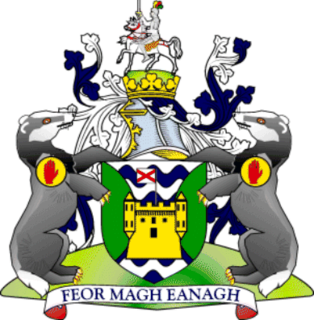
Fermanagh County Council was the authority responsible for local government in County Fermanagh, Northern Ireland, between 1899 and 1973. It was originally based at the Enniskillen Courthouse, but moved to County Buildings in East Bridge Street, Enniskillen, in 1960.
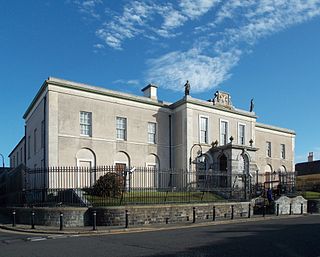
Downpatrick Courthouse is a judicial facility on English Street, Downpatrick, County Down, Northern Ireland. The courthouse, which served as the headquarters of Down County Council from 1878 to 1973, is a Grade B+ listed building.
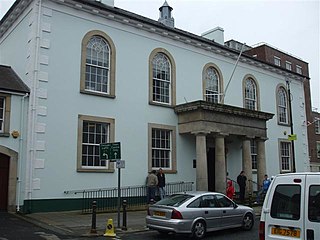
Enniskillen Courthouse is a judicial facility in East Bridge Street, Enniskillen, County Fermanagh, Northern Ireland. It is a Grade B listed building.
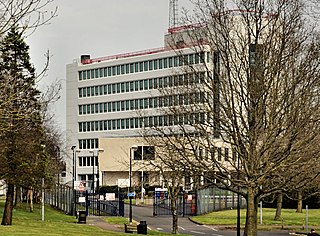
County Hall is a municipal facility in Coleraine, County Londonderry, Northern Ireland. It served as the headquarters of Londonderry County Council from 1960 to 1973.

Armagh County Council was the authority responsible for local government in County Armagh, Northern Ireland.
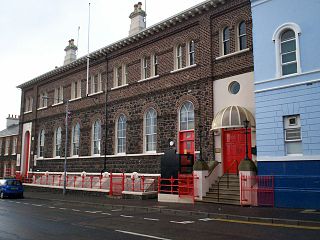
Lurgan Town Hall is a municipal structure in Union Street, Lurgan, County Armagh, Northern Ireland. The structure, which is primarily used as a community, arts and resource centre, is a Grade B1 listed building.















